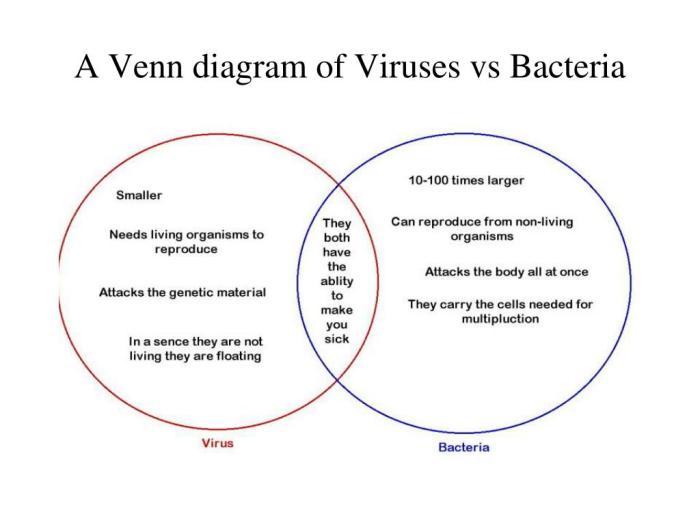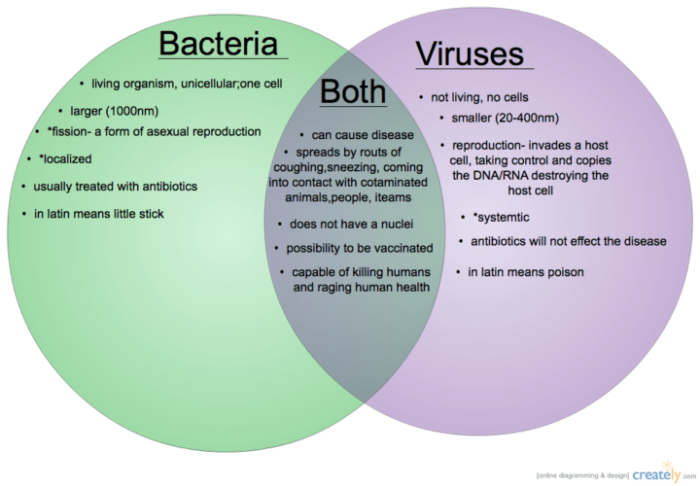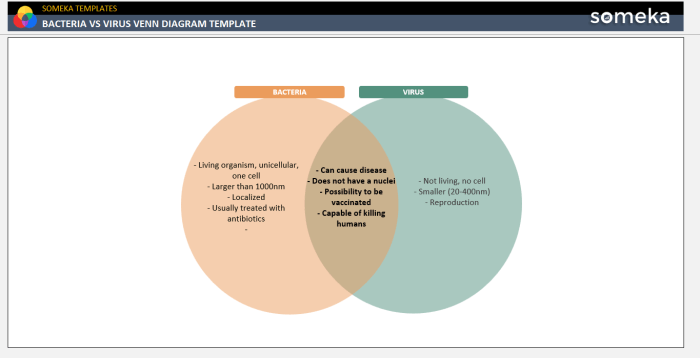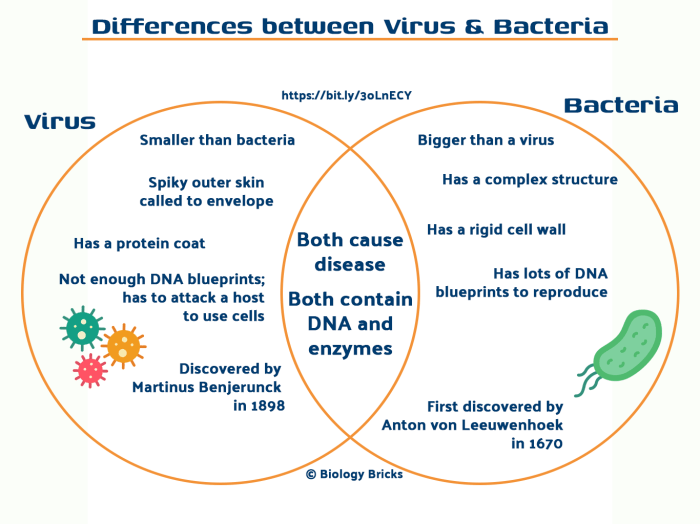Venn diagram of virus and bacteria – Introducing the comparative analysis of viruses and bacteria through a comprehensive Venn diagram, this article delves into the fundamental similarities and differences between these two distinct microbial entities. By exploring their structure, transmission, pathogenicity, and treatment strategies, we unravel the intricate tapestry of their interactions with living organisms.
Characteristics of Viruses and Bacteria

Viruses and bacteria are two distinct types of microorganisms with fundamental differences in their structure, size, and genetic material. Viruses are acellular entities, lacking a cell membrane, cytoplasm, or organelles. They consist of a protein coat (capsid) that encloses a core of genetic material, either DNA or RNA.
In contrast, bacteria are single-celled organisms with a cell membrane, cytoplasm, and various organelles. They have a larger size range than viruses, typically measuring several micrometers in length. Their genetic material is typically organized in a circular chromosome located in the cytoplasm.
Common examples of viruses include influenza virus, HIV, and herpes simplex virus. Examples of bacteria include Escherichia coli, Staphylococcus aureus, and Streptococcus pneumoniae.
Venn Diagram Intersections
A Venn diagram can be used to visually represent the similarities and differences between viruses and bacteria. The overlapping area of the diagram represents the characteristics that both groups share, such as the ability to cause disease. Other characteristics, such as the presence of a cell membrane or the type of genetic material, are unique to either viruses or bacteria.
Transmission and Infection
Viruses and bacteria have different modes of transmission. Viruses are typically transmitted through contact with infected individuals or through airborne droplets. Some viruses, such as the influenza virus, can also be transmitted through contact with contaminated surfaces. Bacteria can be transmitted through contact with infected individuals, contaminated food or water, or through contact with soil or animals.
Once transmitted, viruses and bacteria establish infections in host organisms by different mechanisms. Viruses enter host cells and use the host’s cellular machinery to replicate their genetic material. Bacteria, on the other hand, can replicate independently outside of host cells.
Pathogenicity and Disease
Pathogenicity refers to the ability of microorganisms to cause disease. Both viruses and bacteria can be pathogenic, but they do so through different mechanisms. Viruses can damage host cells by disrupting their normal function, leading to cell death or impaired function.
Bacteria can cause disease by producing toxins or by invading and destroying host tissues. Some viruses and bacteria are highly pathogenic, causing severe or even fatal diseases, while others are relatively harmless.
Treatment and Prevention, Venn diagram of virus and bacteria
Treatment for viral and bacterial infections involves different approaches. Antiviral drugs are used to treat viral infections by targeting specific viral proteins or processes. Antibiotics are used to treat bacterial infections by killing or inhibiting the growth of bacteria. In addition to treatment, preventive measures can be taken to reduce the spread of viruses and bacteria.
These measures include hygiene practices, such as handwashing and covering coughs and sneezes, and immunization, which involves the use of vaccines to stimulate the body’s immune response against specific pathogens.
Expert Answers: Venn Diagram Of Virus And Bacteria
What is the fundamental difference between a virus and a bacterium?
Viruses are acellular entities that require a host cell to replicate, while bacteria are single-celled organisms capable of independent reproduction.
How are viruses and bacteria transmitted?
Viruses can be transmitted through contact with infected individuals, contaminated surfaces, or airborne droplets, while bacteria can be spread through contact with contaminated food, water, or surfaces.
What is pathogenicity, and how does it relate to viruses and bacteria?
Pathogenicity refers to the ability of microorganisms to cause disease. Viruses and bacteria possess varying degrees of pathogenicity, with some causing mild infections and others leading to severe or life-threatening illnesses.


